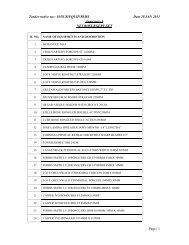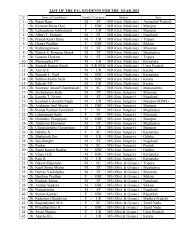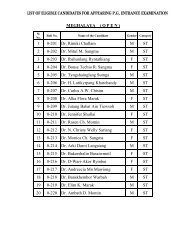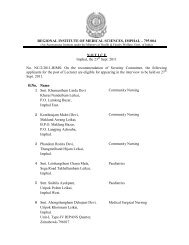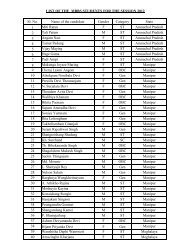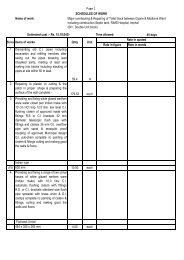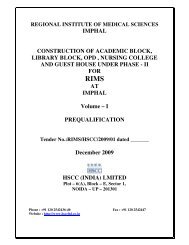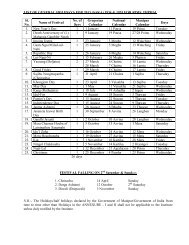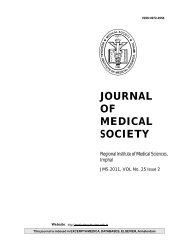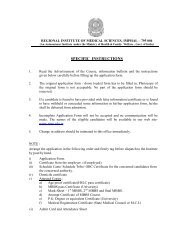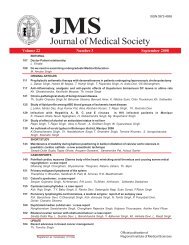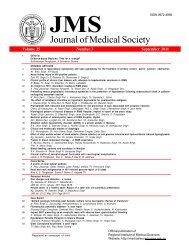Evidence-based Medicine: Time for a change? - Journal of Medical ...
Evidence-based Medicine: Time for a change? - Journal of Medical ...
Evidence-based Medicine: Time for a change? - Journal of Medical ...
You also want an ePaper? Increase the reach of your titles
YUMPU automatically turns print PDFs into web optimized ePapers that Google loves.
ORIGINAL ARTICLE<br />
Among the gram negative organisms, both the<br />
Pseudomonas aeruginosa and Acinetobacter<br />
baumannii isolates were sensitive to Amikacin,<br />
Table 1: Number and types <strong>of</strong> bacteria from positive<br />
cultures<br />
Bacteria Organism Osteomyelitis<br />
n=19<br />
Gram positive S.aureus 13<br />
(68.3)<br />
CONS 04<br />
(21.1)<br />
Total 17<br />
(89.4)<br />
Gram negative Pseudomonas aeruginosa 01<br />
(5.3)<br />
Acinetobacter baumanii 01<br />
(5.3)<br />
Total 02(10.6)<br />
*Figures in parentheses indicate the percentage<br />
Table 2: Antimicrobial susceptibility pattern <strong>of</strong> Grampositive<br />
bacteria<br />
Antibiotics Staphylococcus CONS<br />
aureus (n=13)<br />
(n=04)<br />
S I R S I R<br />
Erythromycin 10 00 3 3 00 1<br />
(76.9) (23.1) (75) (25)<br />
Gentamicin 8 00 5 3 00 1<br />
(61.5) (38.5) (75) (25)<br />
Cipr<strong>of</strong>loxacin 9 00 4 1 1 2<br />
(69.2) (30.8) (25) (25) (50)<br />
Piperacillin- 7 1 5 3 00 1<br />
tazobactam (53.8) (7.7) (38.5) (75) (25)<br />
Vancomycin 13 00 00 4 00 00<br />
(100) (100)<br />
Cefotaxime 6 03 4 1 1 2<br />
(46.1) (23.1) (30.8) (25) (25) (50)<br />
Oxacillin 00 00 13 00 00 04<br />
(100) (100)<br />
*Figures in parentheses indicate the percentage<br />
Gentamicin, Piperacillin-tazobactam.<br />
The isolates showed resistance to<br />
Ceftazidime, Ceftriaxone, Cipr<strong>of</strong>loxacin and<br />
Co-trimoxazole.<br />
Discussion: According to Resnick D 7 , the<br />
distribution <strong>of</strong> osteomyelitis is greatly<br />
influenced by the age <strong>of</strong> the patient, the<br />
specific causative organism and the presence<br />
or absence <strong>of</strong> any underlying disorder or<br />
situation. In this study, the maximum patients<br />
belong to the age group <strong>of</strong> 0-15 years. In all<br />
the age groups, males (66.7%) were<br />
predominant over the females (33.3%)<br />
comparable to a study by Waldvogel FA et al 8<br />
and Duthie and Nelson. 9<br />
The maximum number <strong>of</strong> cases <strong>of</strong><br />
osteomyelitis was seen in the summer<br />
months <strong>of</strong> April to July which constituted more<br />
than half the total number <strong>of</strong> cases. A similar<br />
finding was reported by Mukhopadhyay B 10<br />
wherein it was stated that osteomyelitis was<br />
more common in summer and rainy seasons.<br />
A culture positivity rate <strong>of</strong> 52% was observed<br />
in this study, consistent with findings <strong>of</strong><br />
Vishwakarma and Lal 11 and Kundsen and<br />
H<strong>of</strong>fman 12 . In this study, majority <strong>of</strong> the<br />
isolates were gram- positive organisms<br />
(89.4%). Gram-negative organisms<br />
constituted 10.6%. Mixed infection was seen<br />
in 2 cases.<br />
Staphylococcus aureus (68.3%) was the<br />
commonest isolate comparable to studies by<br />
Gupta U and Bhattacharya AN 13 Ng<br />
Brajachand et al 14 and Dhawan et al 15 .<br />
However the relative rates <strong>of</strong> Staphylococcus<br />
aureus vary from centre to centre. Classen<br />
et al 16 reported as low as 16.3%.<br />
Staphylococcus aureus and Staphylococcus<br />
epidermidis are the 2 major pathogens<br />
responsible <strong>for</strong> most cases <strong>of</strong> osteomyelitis<br />
in the present study.<br />
There was no isolation <strong>of</strong> anaerobes. It could<br />
probably due to the fact that anaerobic<br />
organisms require very stringent conditions<br />
<strong>for</strong> isolation and transportation which could<br />
not always be maintained.<br />
Consistent susceptibility (100%) to<br />
Vancomycin is retained in this study. Most <strong>of</strong><br />
the isolates <strong>of</strong> Staphylococcus were sensitive<br />
to Erythromycin. All the Staphylococcal<br />
isolates showed resistance to methicillin.<br />
Onche I and Adedeji O 17 also reported<br />
Staphylococcus aureus completely resistant<br />
to oxacillin in a hospital setting and inferred<br />
that this was not unconnected with abuse <strong>of</strong><br />
antibiotics by the populace related to over the<br />
counter selling <strong>of</strong> antibiotics.<br />
44 JMS * JMS Vol 25 * Vol * No. 25 3 * No. * September, 1 * June, 2010 2011



